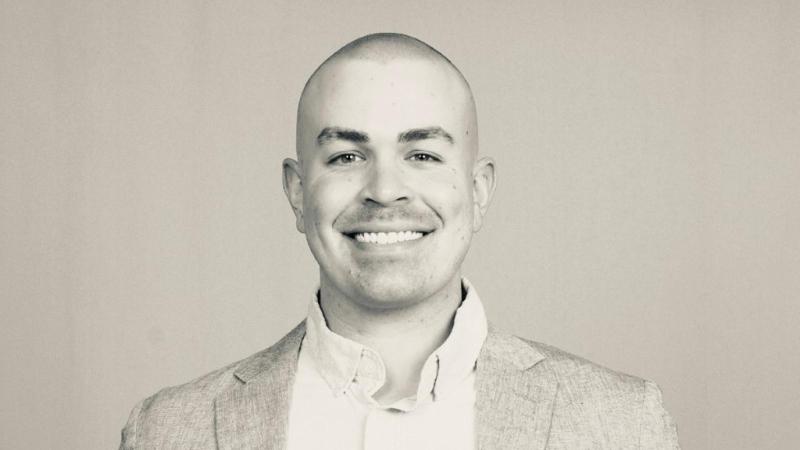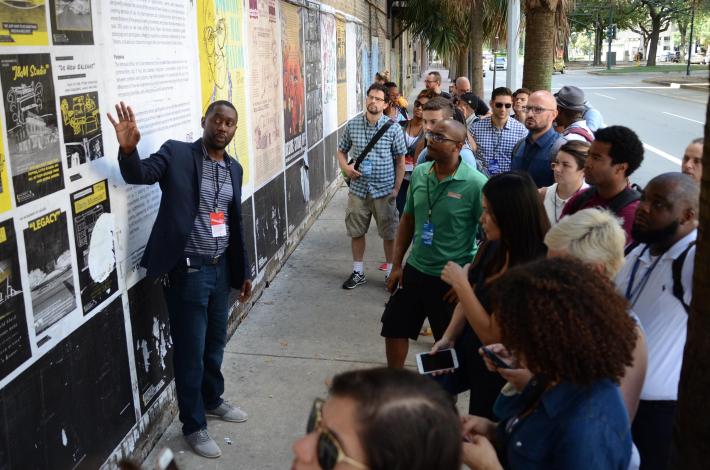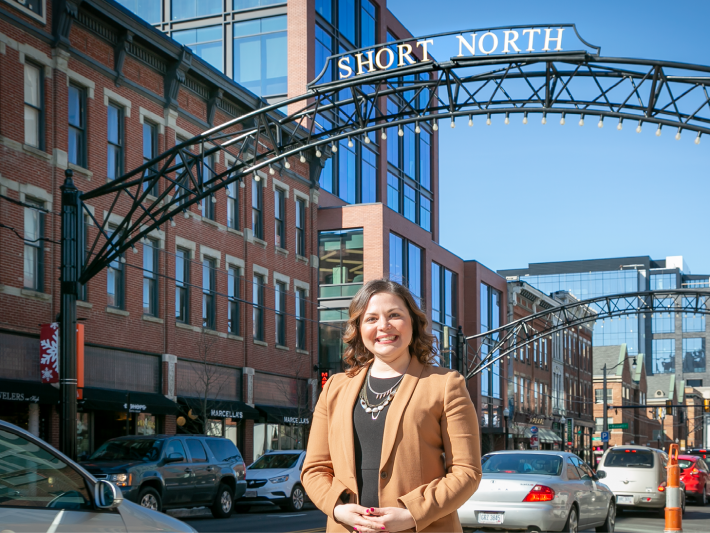Making Connections: Planning, Airports, and the Importance of Networking
City and Regional Planning alumnus Ryan Dittoe talks about the complexity of airport planning, working with attention to LGBTQ+ communities, and the importance of building and maintaining professional networks.

Making Connections: Planning, Airports, and the Importance of Networking
City and Regional Planning alum Ryan Dittoe is an Aviation Planner based at Mead & Hunt’s Chicago office, a national firm whose planning, design, and construction services span a wide variety of sectors. He was recently named a Transportation Influencer by the Transportation Research Board (TRB), an organization that provides leadership in transportation improvements and innovation, and he currently serves as Chair of TRB’s Young Members Council for Aviation.
Dittoe graduated from the Knowlton School with a Bachelor of Science in City and Regional Planning in 2015 and a Master of City and Regional Planning in 2017. As an MCRP student, Ryan focused on airport planning, design, and management.
We talked to Ryan about his work as an aviation consultant, current trends in the industry, and the importance of mentorship.
Can you tell us about your airport master planning work at Mead & Hunt? What is the day-to-day work of an airport planner?
The master plan is the foundation that details the direction an airport should go over time. Consultants create plans that look holistically at an airport to understand, in essence, what is there now, what will be there someday, and what needs to happen there to accommodate those changes—think roadways, parking lots, curb-front capacity, check-in halls, security checkpoint configurations, concession space, aircraft gates, runways and taxiways, airspace issues, support facilities, and everything in between.
As planners, we make recommendations about how best to situate the airport for the future, how such changes could be funded, and how to sequence these developments into overall capital programming. We conduct analyses to understand and mitigate environmental impacts and engage with stakeholders and the public to work toward project buy-in. It’s a long process, but it’s required for the progress of an airport.
Aviation consulting positions allow you to work on a multitude of projects at the same time, so the day-to-day tasks change but are pretty consistently fast-paced. I could be working on multiple airport master plans, business development opportunities for the company, staying involved with industry trade organizations, interfacing with clients, researching creative ways to approach project problems, and more.

You graduated from the Knowlton School with both a bachelor’s and a master’s. Can you talk about your Knowlton and Ohio State experiences? What led you to pursue a career in aviation?
I was busy all the time! But I loved my days at Ohio State—and at Knowlton specifically.
There are five doctors in my family so I thought I wanted to go into medicine. I started as a biology major at another university and quickly realized it wasn’t for me. I transferred to Ohio State as an undecided major and took the introductory City and Regional Planning class and I declared a CRP major soon after.
I think growing up in rural Ohio made cities electrifying to me. I also like aviation but had less of an interest in it since I didn’t know what I would do if I wasn’t a pilot. I took an elective aviation course, and I was compelled to consider how the two disciplines could be joined into a career.
During a CRP studio course on developing a light rail transit system in Columbus, I liked thinking about connecting the routes to the airport and understanding how that might look in the real world. I got to know some of the planning staff at the Columbus Regional Airport Authority and, from that relationship, ultimately became an intern with their Planning and Engineering department. It was right around then that I decided to make aviation planning my focus.
While in the MCRP program, I worked as a Teaching/Research Assistant for Ohio State’s Center for Aviation Studies, which brought me more exposure to the industry, professional networking, and time to think about what I wanted to do after graduation. I liked that aviation felt special, and I still think it is. It’s fun to talk about with people unfamiliar with it.
All of it took hard work, and I am endlessly thankful to the professors who mentored me, brought opportunities to me, and made me see that no one can do it alone.
You worked as an airport planner in the Sacramento County Department of Airports prior to joining Mead & Hunt. What aviation industry trends, perhaps specifically in the Midwest, do you foresee on the horizon? What planning issues define the Midwest versus the West?
A lot of the issues faced by the industry are the same regardless of where they are in the country. Airports are federally governed and the industry as a whole is dealing with pilot shortages, funding constraints, aging infrastructure, and the realization that aviation has significant impacts on our climate.
Regionally speaking, I saw firsthand how important aviation is in fighting wildfires when I lived near a CAL FIRE air tanker base in Sacramento. Now that I live in Chicago, I think about how snowfall affects aircraft operations and what’s required of the airport and its staff to ensure minimal weather disruptions. These are distinctive challenges we have to prepare for and they will continue to define aviation’s role in transporting and protecting people and property.
Industry-wide, I think we’ll see more issues—but solutions too—having to do with the collection and use of traveler data, sustainability and reuse of infrastructure, alternative fuel sources like electricity and hydrogen, and airports’ needs and roles in preparing for and accommodating that technology. These are multi-faceted issues; also consider the legal, environmental, workforce, financial, and security characteristics of each.
Most importantly, across the entire industry, there must be greater emphasis placed on the diversity, equity, and inclusion of people who haven’t always had a seat at the table. I’m hearing and am a part of more of these conversations, but we have a responsibility to put our words into movement.
On a related note, the John Glenn Columbus International Airport has announced plans for a new terminal. What opportunities do see in the new terminal and the region?
Projects like this don’t happen all the time, so I am excited to watch how it unfolds. Building a terminal from the ground up presents a chance to remedy the obstacles that might exist in the current terminal.
From a practical standpoint, the integration of new security and customer service technology, contemporary amenities, and avenues for revenue generation is important.
But more than any of that, I hope to see a facility that is planned and designed with all types of travelers in mind: business and leisure travelers, sure, but there should be deep contemplation of the needs of aging passengers and those with physical and cognitive disabilities.
Airports are naturally the first and last touchpoint for visitors to the city, so it will be paramount to practicably and artfully represent what it means to be Columbus.

You were recently named a Transportation Influencer by the Transportation Research Board, an organization that provides leadership in transportation improvements and innovation. As someone in a position of influence, what advice would you give to current students and young planners who may be interested in pursuing a career in aviation?
It may be trite to say it, but I still really think it is who you know and not necessarily what you know. I attribute much of my career’s progression to having built and maintained a network of industry connections, and I am definitely still building it. In terms of advice, here’s what I have picked up over the years:
- If you are a student or young planner, you will benefit from taking the time to be aware of current events, especially as you are orienting yourself with the industry.
- Don’t let minimal experience hinder you from pursuing what sounds fun—even if you don’t like it, you’ll learn something about yourself.
- Be open to relocating and doing things that make you uneasy.
- Don’t wish away your college or early job days. Enjoy your time where you are and remember how it feels. That pinnacle everyone seems to be trying to reach is actually right where you are.
In January 2022, you became Chair of the TRB’s Young Members Council for Aviation. At Mead & Hunt, you are involved with the Advanced Air Mobility and Electrification Working Group, Young Professionals group, and Employee Resource Group LGBTQ+ subgroup. Can you elaborate on what draws you to these leadership and mentorship roles, and how professional engagement can create a positive culture and community in the workplace?
TRB’s Young Members Council for Aviation has been invaluable for me. I’ve gotten to know people from other consulting firms, a number of airports, government employees, academicians, researchers, and lots of other impressive folks. As Chair of the group, I get to develop and practice my leadership skills, and I’ve also made new friends.
Most of what I know was learned by working with other people or putting myself into new settings that force me to develop or refine a skill. I didn’t come from an aviation background, so for a while, I relied on the help of my peers while I was in school and then on my peers in the workplace to really position myself for a long-term career in aviation.
I keep saying that I’m seeing firsthand just how much we need each other, and it’s fulfilling to reciprocate the mentorship I received as a student. It’s a confidence boost to watch your own evolution into a person who can speak to things you used to not know anything about.
The groups I am a part of don’t feel like work. Yes, they’re resume-builders, but professional engagement can be fun and it usually fosters connections across a team, which usher in new ideas and approaches to ongoing work. You spend a huge amount of your life with your colleagues, so it’s worth getting to know them outside of your nine to five.
As a member of the Employee Resource Group LGBTQ+ subgroup, can you offer advice for planners in the LGBTQ+ community? And can you talk about how planners can work with attention to LGBTQ+ communities and issues?
I’ve learned that living life in a way that’s genuine will take you much farther personally and professionally than living any other way. That authenticity will show itself in your performance and in the way you engage with other people—whether that’s a colleague, a client, or the public. So to start, I would say it’s essential to create a strong, truthful foundation for yourself. This also allows others to see representation of themselves in you. Knowlton always felt like a safe space for me to do that, so I hope students there feel free to be themselves while they learn.
Planning is a very public-facing career; we plan and design spaces to be used by society. Of course, there are non-negotiable regulations and policies that we follow, but there is also a need to understand the users of what you are planning.
Kyle Ezell is one of my favorite people and professors at Ohio State. He wrote an article, “Three Essential Questions for Better Planning,” which poses three questions for planners to consider as an approach to their work: Who is helped? Who is harmed? Who is missing? These questions encompass what it means to account for everyone at the drawing board.
Other suggestions to planners are: understand public health and safety concerns for demographics other than your own; work to incorporate diverse groups of people into your project teams, and if you’re a decision-maker for your company, consider the inclusivity and protections of your own policies; and know about and celebrate the histories of those for whom you’re planning.
What aspects of your education in the planning program at Ohio State have been valuable in your professional practice?
I am immeasurably thankful for the education, resources, and people to which I had access at Ohio State. It was in the Knowlton School where I began to conduct research and where I developed and honed my writing and presentation skills. My studio courses tempered the anxiety I had about working for real-world clients and making cold calls to actual professionals. Those experiences continue to remind me that we all have to start somewhere and we’ll always be learning.
Graduates of the Knowlton School embody the skill and professional aptitude demonstrated to us by our professors. I’m proud to be a twice-graduate of Ohio State. There is something really great about coming from such a renowned institution and the lifelong commonality of being a Buckeye. When I introduce myself in a meeting, it’s always gratifying when someone else in the room emphasizes THE.




